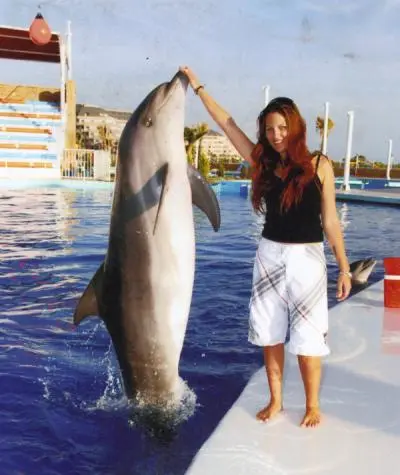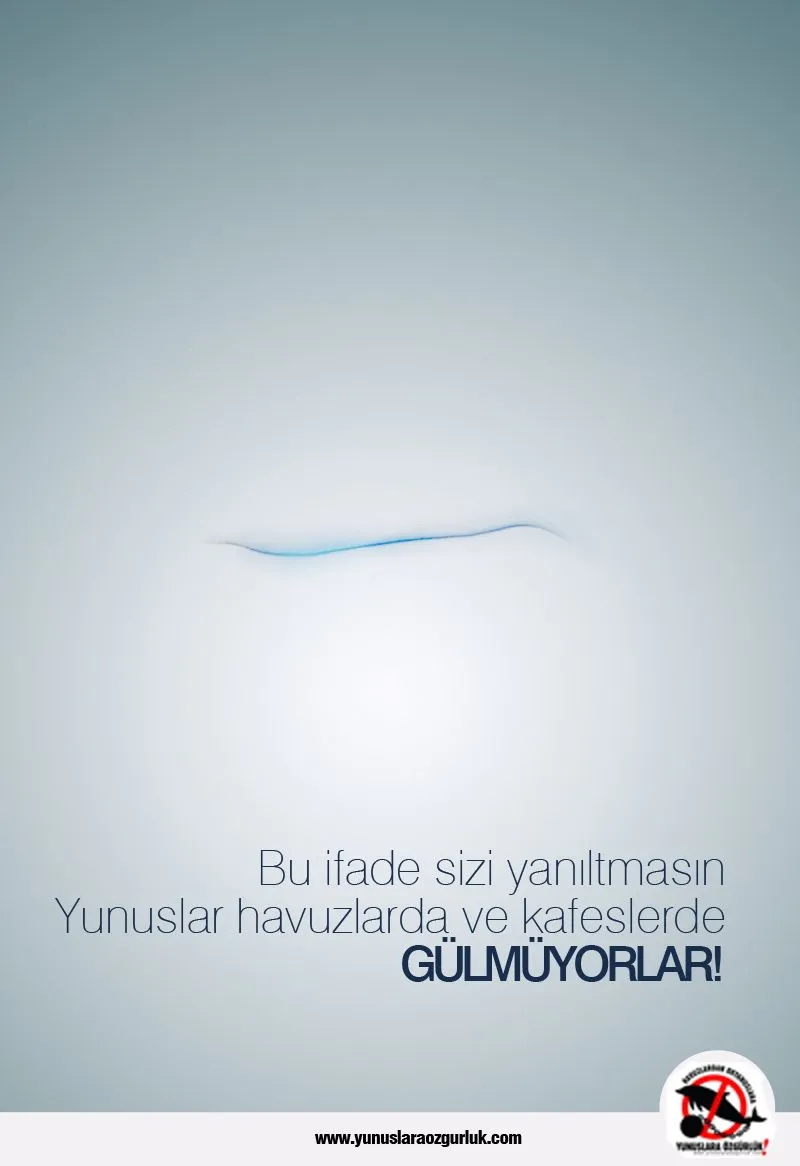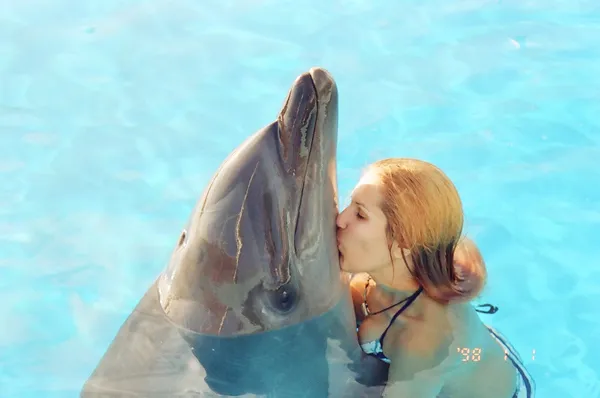Didem Arakon and Öykü Yağcı from Freedom for Dophins Platform (FFDP) met Melisa Sevim, an ex-dolphin trainer, by the video she prepared about dolphin parks called “The Other Side of the Medal; Marine Parks”. On February 2011, she told us her new objectives about marine mammals while she assessed her previous job and answered our FFDP’s questions sincerely.
(Turkish version) (French version)
Hi Melisa, could you tell us about yourself?
Hi, I’m a senior student in the Fisheries Engineering Faculty. I was a dolphin trainer; this is also called a dolphin handler.
What is dolphin training? How is the process?
Mostly, dolphin trainers enter into a dolphin’s life as early as the first time it is captured: they support and help the capture of the dolphins. The captured dolphins are then transported to dolphinariums first where they become accustomed to eating dead fish in the first place, and later to communicating with people. The trainers start taking care of all needs of the dolphins and train them for the shows. The largest number of people working in this sector are from Mexico, followed by Russia, Ukraine and Spain.
Is there a school or a special course to be a dolphin trainer?
There is a two-year program in California called Moorpark College’s Exotic Animal Training and Management (EATM) but this does not give the exact definition of dolphin training. There is ABC Animal Training in Mexico. They offer one-week or sometimes one-month courses. But this job is usually learnt by experience rather than school, and references are more important than a diploma.
Why did you choose this job? What kind of an experience was it for you?
I’ve always dreamed of working with marine mammals ever since I was a child. Even when there was no profession as such, I dreamt of it. While I was working as a dolphin trainer, I never took it as a regular job between the work hours. I was spending my time watching the dolphins from early hours of morning until evening too see if they were OK. However, after a while I saw things that I could not stand anymore and decided to take care of marine mammals in a different way.
What was the actual reason for you to quit?
I saw the death of several dolphins and started to feel hopeless about it. I couldn’t bare the fact that I wasn’t able to save them! This made me consider other options to do more. Then I decided to struggle to protect them.

It seems that what you’ve been through caused you to change your direction completely. What are you doing now?
Now I’m working with Underwater Research Society – Marine Mammals Research Group (SAD – DEMAG) as a volunteer. We have issued the “Dolphins, captives of the pools” report recently.
If we get back to training, how long does it take to make a dolphin get used to eating dead fish, being trained and making shows?
I haven’t trained a newly captured dolphin but in this sector it’s common to see a dolphin getting used to eating dead fish and being trained in almost two months. A simple show requires a 6–month long preparation. These periods also depend on the trainers: if they are not experienced enough, it may take longer. However, the dolphins’ adaptation period is much longer for the ones coming from Japan-Taiji because of the physical and mental trauma they had been through.
DOLPHINS UNDER PHYSICAL VIOLENCE
If the dolphins reject training, are they given less food or are they treated harshly? How is the actual process?
This completely depends on the trainer. When I was a trainer, there was this dolphin I fell in love and had a strong connection with. It was 17 years old, like it was a bit older compared to other dolphins. It would get bored very easily in the training pool and would swim away to the other side of the pool. It didn’t care about the food or the instructions. There was an experienced trainer who got well with it but they were in different pools. This dolphin was obedient to me thanks to the connection I made with it, my compassion and patience. This was my style but I also witnessed a trainer committing violence on a dolphin. Clearly, there are two types of trainers. There are many who do this job merely for money and those are the ones who torture animals, especially the Russian trainers are the cruellest.
What do you mean by “committing violence”?
He was beating the dolphin! This is common: they beat, they kick, and some trainers don’t even give food. Bad trainers do that. The good ones, on the other hand, choose to start from the beginning, trying to cheer up the dolphins with little games during the training sessions. As you can guess, dolphins are getting bored with these trainings.
So can we say violence is also a part of dolphin captivity?
Absolutely! Unfortunately when the dolphins are trained by trainers who do not likes this job and would do it only for money, they are more likely to get exposed to violence and beating.
Are dolphins left hungry?
This also depends on the trainer. A good trainer gives the treat to the dolphin in order not to leave it hungry by making it perform some basic stuff even if the dolphin doesn’t do what it is told to do.
What do you think about “dolphin assisted therapies” (DAT)? Have you ever been to one of them?
Yes, I worked in a therapy pool. I saw a handful of children and families who would not improve and leave after 2 or 3 sessions but also met a few who got positive results. I don’t know what the actual scientific explanation is but the healing and neutralizing effects of the water are usually mentioned. That would be the explanation.
THERE ARE “ANTI-CHILD” AND AGRESSIVE DOLPHINS THAT HURT EACH OTHER OUT OF RAGE
How is the life of a captive dolphin?
They struggle immensely to live with different species in the same environment. Especially male dolphins in mating season get very nervous as they are not in same pools with female dolphins. They are kept in a very small space and their sonar system is utterly collapsed in a confined pool. Captivity is a state in which the dolphins become dependent on human and literally get spoiled. Despite everything, sometimes they try to have fun and get rid of the boredom by playing with their toys. They may also have very harsh fights with each other: I know a dolphin smashing another’s fin. These are the realities people do not even know. A captive dolphin’s life does not wholly consist of what people see in shows.
I WAS ALMOST KILLED!
We know of captive dolphins and whales that harmed their trainers out of aggression. Have you ever experienced such a thing?
Yes; I was almost killed once. I was working with a dolphin who really hated children. I was together with four children in that pool. Suddenly, the dolphin got annoyed with the children and jumped over me so violently from the other side of the pool that it almost fell on me, an animal of 200-250 kg! Luckily it fell near me. I remember distracting the attention of the children by not getting them panicked and taking them away. That dolphin did this when it was not included in a swimming program or given any instructions. This is one of the dangers that should not be underestimated. I suggest the enthusiasts to make a little research on the internet and watch the videos they find. These reactions may be due to many things including captivity, being left hungry, getting angry, etc… You wouldn’t really like to make a dolphin angry!
What do they do when they get angry?
My first swimming experience with dolphins was with very unhappy and angry dolphins. They hated what they were doing so much! After I swam with them, the trainer gave them their treat and the session was over. As I didn’t know the session was over, I tried to go on swimming with them and dived together with one of them. All of a sudden, he shook me off his back and pushed me away. We can say that he beat me in his own way. I mean he said “I did what I had to do, why are you still chasing me?”
THEIR FINS BEND BECAUSE OF CARRYING HUMANS
So, what are the dangers of swimming with dolphins for the dolphins?
First of all, the biggest mistake is holding their dorsal fin and swimming like this. The fin on their back is made of cartilage, not made of bone as the pectoral fins. The dolphin that didn’t want to swim with me in 2005 is now in İstanbul and his dorsal fin is bent.
Female dolphins in dolphinariums are mostly known to give stillbirth babies. What is the reason for this?
Because the animals continue to make their shows even when they are pregnant! There is a performance bit called “beaching”. The dolphins stand on the platform near the pool, putting their caudal fin in vertical position. This directly causes the fetus die. Female dolphins swim all the time while they give birth in their natural environment. But under captivity, the pools are too small to do this. It is also possible for the baby dolphin to suffocate, if the mother cannot get the required vaginal opening. And also not having a veterinarian in many of the parks causes this too. This is because the specialist veterinarians come from abroad and the parks do not prefer to do this as it would cost them a lot.
We think we can have an empathy with dolphins but what about the people who come for swimming sessions? Do they realize the effects of the captivity on dolphins?
No, not during the shows… They usually come and leave very happily.
You remind us the creator of The Cove, Ric O’Barry, in terms of your decision to quit dolphin training and becoming a libertarian/activist. Your stories are quite similar. What do you think about Ric O’Barry?
I really appreciate him. I contacted him to ask if I could use the images on The Cove in order to raise public awareness in my country. He instantly replied me and gave me the permission for the photos. When I finished the video, I sent him and he quite liked it.
THERE ARE TRAINERS WHO “DON’T EVEN CARE”
In the last few years, all the hidden secrets of this sector have been revealed. How did this affect the trainers? Is everybody so reactive like you or are there reckless people?
There are trainers who want to quit but can’t because of financial issues. I’m sure they are going to quit in a few years. Unfortunately, some of them think differently; they say “I have a good job where I work with animals. People get my cool photos and I charm girls/boys this way. I really don’t care about the rest!”
What are your plans for the rest of your life?
First of all, I don’t want to be a part of any commercial activity involving these animals. I mean I don’t want to earn money on them. Instead, I want to participate in voluntary activities. So I will change the direction of my career and have a different profession. But I will go on to take part in different projects voluntarily for all the marine mammals.
Do you have a message for the ones who dream of “being together” with dolphins and becoming a dolphin trainer?
I suggest them to work for rehabilitation centres to heal them and make them free instead of training them and making them captives.
Melisa, do you think the dolphins are “smiling”?
I believe I made this issue very clear in the video I prepared. Everyone thinks that they indeed smile but you can see the same expression when they are dead as well…

What would you like to say as the last words of our interview?
This sector owes its existence to people showing interest in dolphin shows. When people quit going to dolphinariums, these centres will not keep on earning money and they will shut down inevitably. But first of all, being aware of the situation and raising awareness among others is necessary. People should stop going to dolphinariums and inform others around them.
Thanks for this nice conversation Melisa.
Same here. I’m glad to have met you!
Photos: Melisa Sevim
Translation: Ayşegül Seç
Click here to watch “Other Side of the Marine Parks” video.

